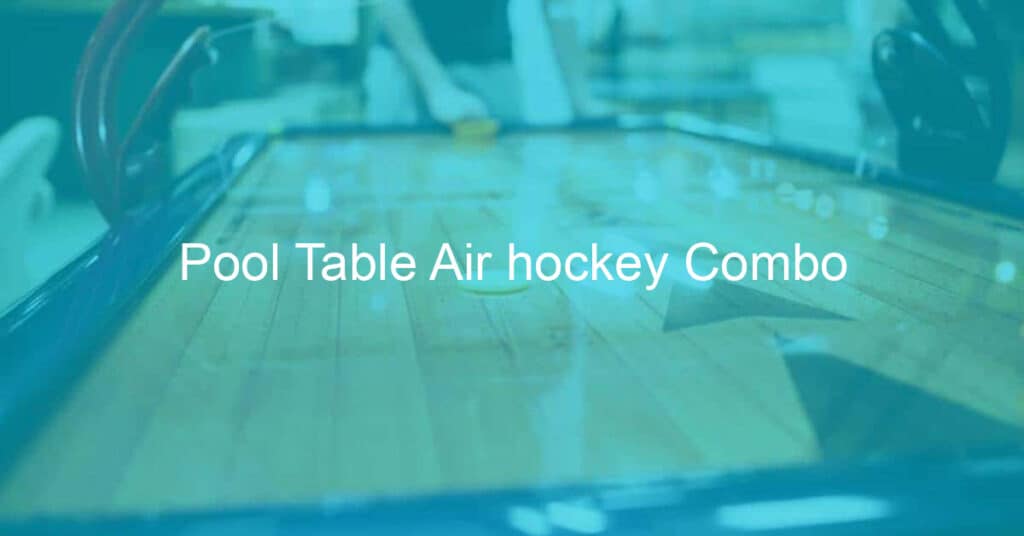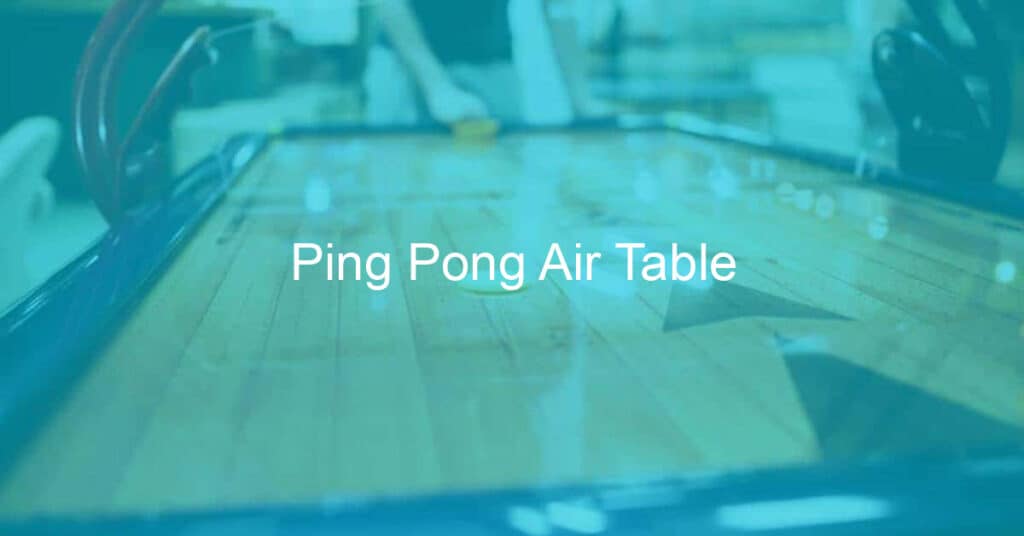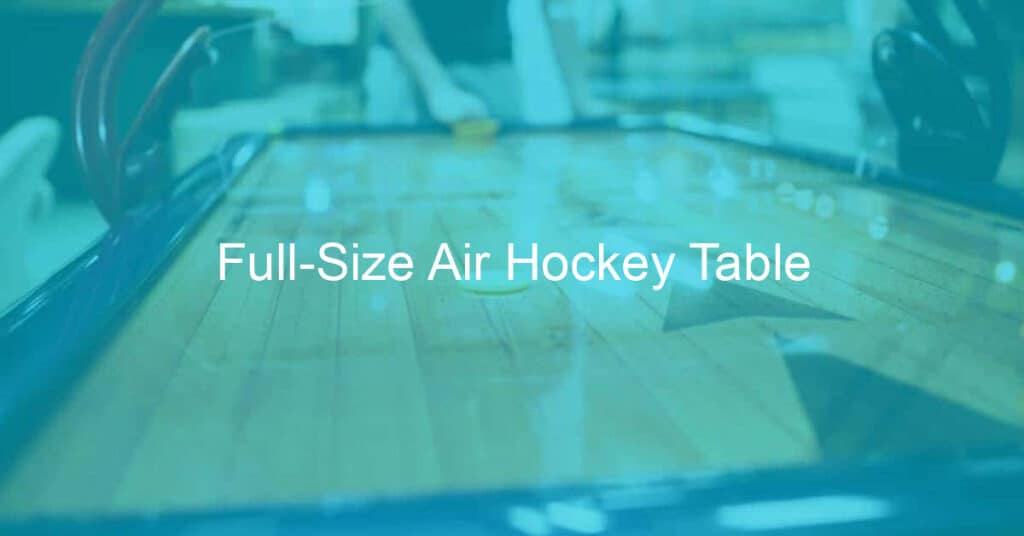An air hockey puck is a small, flat disk that players use to waggle balls on the hockey table. A puck is rigid and uses hard rubber for balanced motion.
There are different pucks for different hockey tables, and their speed also varies.
Air hockey pucks move at an average speed of 80 miles per hour. Although the pucks can reach these speeds, the 80mph depends on various factors.
This article will discuss different factors that accelerate or decelerate your air hockey puck.

How to Calculate Air Hockey Puck Speed
To calculate your air hockey puck speed, you need to record the time your puck takes from one side of your table to the other. Then measure the distance between the two points.
Use the formula: Distance x time = Average Speed or velocity.
You can use a stopwatch or a speed gun to take time.
Factors That Affect the Speed of Your Air Hockey Puck
Size of Air Puck to Table Size
The air puck size to table size ratio affects airflow. The airflow is strong on larger tables compared to small tables. Bigger air pucks have a large surface area for use on large tables and vice versa.
If you use a large air puck on a smaller table, the friction will be more; hence the puck will move slowly since the airflow on the small table cannot lift the puck.
On the other hand, if you use a small air puck on a larger table, the travel distance for the puck will be longer, and the puck will move slower.
The Air Holes on Hockey Table
Air hockey tables have holes to blow air across the table surface to lift the pucks and glide.
The air holes increase your puck’s speed by reducing the friction that would otherwise be there if there were no holes on the hockey table.
Force of the Hit
The force with which the player strikes the puck directly affects the speed of the puck. When a player strikes, the puck responds to the strength of the hit.
7 Ways to Make Your Air Hockey Puck Go Faster
Various factors affect the speed of your air hockey puck. Besides the weight of the puck and the force with which the player hits, there’s so much more.
Here are some of the factors that can affect the speed of your air hockey puck.
- Air Flow- The amount of air that flows out of the holes on the hockey table surface determines the speed of your puck. If the air coming out is too little, the puck will move slowly. Always ensure the air blower works perfectly and pumps air at the correct rate.
- Clogged air holes- The airflow will be affected if your hockey table has obstructed holes. Always ensure the holes are regularly cleaned for free flow.
- Size and weight of the air puck- Different sizes and weights of air pucks work for different hockey tables. The larger the table, the heavier the air puck should be. You’ll achieve the correct speed if you get the right puck for your table size.
- Use Silicone Lubricant on the table- Silicone helps to make your hockey table surface slicker. With a smooth table surface, the puck slides faster.
- Replace worn-out pucks- If your air hockey pucks are worn-out, they’ll not move as fast as they should. Always replace them in time.
- Use hockey-approved polish- To polish your air hockey table, use the suitable polish to achieve a slick surface for more speed and less friction.
- Clean the hockey table- A dirty table slows down your hockey puck. You’ll need to keep your table surface clean to reduce friction, so your puck speed is not slowed down.
Frequently Asked Questions
Why Do Air Hockey Pucks Fly Off Tables?
Pucks fly off the table if there’s something wrong with them. Usually, it indicates excess airflow on a very light puck.
Most tables don’t have a way to reduce the amount of airflow on the table, so the puck flies off.
| Ways to Increase Puck Speed | Description |
|---|---|
| 1. Reduce Friction | Minimize friction between the puck and the table surface by keeping the table clean and using a smooth playing surface. |
| 2. Use a Heavier Puck | Opt for a heavier puck as it will have more momentum and travel faster when struck. |
| 3. Improve the Striking Technique | Practice and refine your striking technique to ensure maximum force and accuracy when hitting the puck. |
| 4. Optimal Striking Location | Aim to strike the puck closer to the center as it maximizes the transfer of energy and increases the speed of the puck. |
| 5. Increase Air Flow | Enhance the airflow across the table by adjusting the air blower or using additional fans to create a faster playing environment. |
| 6. Reduce Air Leakage | Minimize air leakage from the table edges or gaps by ensuring proper maintenance and sealing any openings. |
| 7. Choose a Powerful Air Blower | Upgrade to a more powerful air blower system that generates stronger and faster airflow, propelling the puck at higher speeds. |
How to Do Air Hockey Pucks Float?
The table surface of the air hockey table has tiny holes that let air through the entire playfield from underneath at high pressure.
The air, which flows at high velocity, floats your pluck as it counters its weight.
How fast does an air hockey puck travel?
Air hockey is a popular game among kids and adults alike, but have you ever wondered how fast that puck is flying across the table? Well, the answer might surprise you. On average, an air hockey puck can travel at a speed of up to 80 miles per hour!
That’s faster than most cars travel on the highway. The swift movement of the puck is made possible by the air cushion that is created between the puck and the table, reducing friction and allowing it to glide across the surface. So next time you play a game of air hockey, keep in mind just how fast that little puck can move.
How does an air hockey puck work?
Air hockey is a fun and lively game that brings excitement to all who play it. But have you ever paused to consider how an air hockey puck works? The puck, which is typically made of plastic, is designed to glide smoothly on the surface of the table due to the constant stream of air that is forced out of thousands of tiny holes in the playing surface.
This air cushion reduces friction and allows the puck to move quickly back and forth, making for a fun and fast-paced game. As players hit the puck back and forth, they are transferring air pressure from their mallet to the puck, sending it flying across the table. So the next time you play a game of air hockey, take a moment to appreciate the ingenuity behind this entertaining and fast-paced sport.
Adjust your paddle’s tilt angle to ensure maximum rebound when striking the puck
One key to mastering the game of air hockey is learning to adjust the tilt angle of your paddle. By tilting the paddle at just the right angle, you can ensure that your strikes against the puck result in a maximum rebound – giving you the upper hand in the game.
It might take some practice to get the tilt just right, but once you do, you’ll notice a significant improvement in your gameplay. So, next time you step up to an air hockey table, remember to keep the tilt angle of your paddle in mind as you try to outscore your opponent.
Use a softer mallet or lighter mallet depending on the desired power of your shots
The art of playing music is, in many ways, a balancing act. Sure, there are the technical skills necessary to play a specific instrument well, but there’s also a certain creative element that separates good musicians from great ones.
That creative element often lies in the player’s ability to control the sound they’re producing – from tone and pitch to power and volume. That’s where choosing the right mallet comes in, especially for percussionists.
Whether you’re a seasoned pro or just starting, choosing a softer or lighter mallet can drastically affect the power of your shots. So, experiment a bit and find the right mallet for your playing style. Once you do, you’ll find you have a whole new level of control over your sound.
How do you get a hockey puck in the air?
Hockey is a fast-paced and dynamic sport where players need to be quick on their feet and aware of their surroundings at all times. Getting a puck in the air is a maneuver that requires skill and precision.
One way to do this is to use a wrist shot, where the player quickly snaps their wrist and shoots the puck using the bottom hand’s power. Another technique is to use a slapshot, which involves taking a full swing at the puck and hitting it with the blade.
Whichever technique a player uses, getting a puck in the air takes practice, and perfecting the right technique can make all the difference on the ice.
How big is an air hockey puck?
Air hockey pucks might look small, but they pack a serious punch on the table. Measuring just over 3 inches in diameter and less than an inch in thickness, these disc-shaped pieces can glide effortlessly across the surface of the game without getting stuck in any grooves or dents.
Whether you’re a seasoned pro or a beginner, the size of an air hockey puck is just right for a fast-paced game that demands quick reflexes and precision shots. So grab your mallet and get ready to send that puck flying!
What are air hockey pucks made of?
Air hockey is a thrilling game that is enjoyed by many people across the globe. When playing this game, you may have wondered what air hockey pucks are made of. These small discs are an essential part of the game, and they are designed to glide smoothly on the playing surface.
Air hockey pucks are usually made of a durable plastic material known as polyethylene. This material is specially molded to create a flat, smooth surface that can easily glide across the air hockey table. So, next time you’re playing air hockey, you can impress your friends with some fun facts about the pucks that make the game possible.
Final Word
Air hockey is a fast-paced game where you aim to hit the puck as hard and fast as possible to win.
You will likely enjoy the game when your puck is flying around the table at speed. If the rate is low, you are likely to get worried.
We hope this article will help you address issues affecting your puck’s speed so you can stay in the game.


















